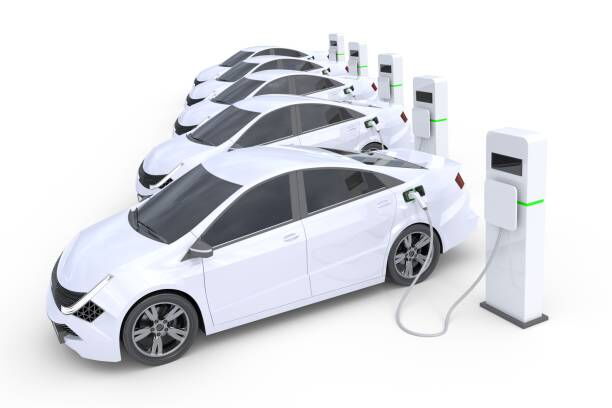On this page
As electric vehicles (EVs) become increasingly popular, ensuring safe charging practices is vital for drivers and the surrounding environment. Whether you’re new to EVs or a seasoned owner, understanding the essential safety measures can help you avoid potential hazards and prolong the life of your charging equipment. Here’s everything you need to know about safely charging your electric car.

Most EV chargers and connectors are engineered to handle rain and other adverse conditions, providing protection against electrical shock.
Charging equipment includes safeguards that prevent current flow if moisture or damage is detected.
However, it’s important to remain cautious. If you notice any damage, such as frayed cables or exposed wires, refrain from using the charger. Report the issue to the charging station owner or customer support as outlined on the charging unit. Additionally, take general weather precautions, such as staying alert for lightning or falling debris.
However, it’s important to remain cautious. If you notice any damage, such as frayed cables or exposed wires, refrain from using the charger. Report the issue to the charging station owner or customer support as outlined on the charging unit. Additionally, take general weather precautions, such as staying alert for lightning or falling debris.
Whenever possible, charge your EV before severe weather hits to avoid complications.
Before connecting your EV, take a moment to inspect the charging station for potential issues. Here’s a checklist to guide you:
Look for visible damage, such as frayed insulation, exposed wires, or corrosion. These can pose electrical hazards.
Examine your car’s charging port for any signs of damage or foreign objects that could interfere with the connection.
Ensure the charging unit itself appears intact, with no obvious signs of wear or vandalism.
Notify the station’s owner or operator immediately.
Use any available instructions on the station to contact customer support or report the issue.
Avoid using the station until it has been inspected and repaired by a qualified technician.
Use any available instructions on the station to contact customer support or report the issue.
Avoid using the station until it has been inspected and repaired by a qualified technician.
While modern EV charging systems are highly reliable, certain risks can arise if safety protocols are ignored. Here’s a deeper look at potential hazards and how to address them:
Using an outlet that isn’t designed to handle your charger’s amperage can lead to overheating and fires. Always use dedicated outlets and avoid overloading circuits.
Although EV chargers are water-resistant, prolonged exposure to moisture can lead to corrosion or short circuits.
Protect your charging station with a cover and ensure connectors are dry before use.
Over time, components like cables and connectors can degrade. Regular inspections and timely replacements are essential to maintain safety.
Charging your EV in a garage or covered area minimizes exposure to weather and reduces risks associated with moisture and debris.
If lightning or severe storms are forecasted, it’s better to wait until conditions improve. Charging in extreme weather, while generally safe, can increase risks if equipment is already compromised.
Many EVs come with built-in safety systems that monitor charging conditions. Familiarize yourself with these features and how they enhance safety.
As EV adoption grows, advancements in charging technology continue to prioritize safety. Innovations such as wireless charging, smart monitoring systems, and AI-driven fault detection are expected to enhance the user experience while reducing risks.
Moreover, industry standards are continuously evolving to address emerging safety concerns. Governments and manufacturers are working together to establish universal guidelines for charging equipment, ensuring that every EV owner can charge their vehicle confidently and securely.
Moreover, industry standards are continuously evolving to address emerging safety concerns. Governments and manufacturers are working together to establish universal guidelines for charging equipment, ensuring that every EV owner can charge their vehicle confidently and securely.
Yes, most EV chargers are designed to be water-resistant and can safely operate in wet conditions. However, ensure that the charging station and your vehicle's charging port are not visibly damaged before use.
EVs themselves are generally safe during lightning storms due to their insulating materials. However, charging during such storms may expose the charger to power surges, which could lead to damage.
If you observe frayed cables, exposed wires, or other damage, avoid using the station. Report the issue to the station owner or operator and wait for professional repairs.
Use a weatherproof cover to shield the charging station outlet and follow manufacturer guidelines for charging in wet or humid conditions.
Charging an electric vehicle is a straightforward process, but safety should always remain a priority. By following manufacturer guidelines, inspecting equipment regularly, and taking extra precautions during bad weather, you can ensure a safe and reliable charging experience for your EV.
As electric vehicles continue to transform the automotive landscape, embracing safe charging practices will help both seasoned and new EV owners maximize their vehicles’ potential while minimizing risks. Stay informed, stay cautious, and enjoy the benefits of driving electric.
As electric vehicles continue to transform the automotive landscape, embracing safe charging practices will help both seasoned and new EV owners maximize their vehicles’ potential while minimizing risks. Stay informed, stay cautious, and enjoy the benefits of driving electric.